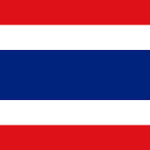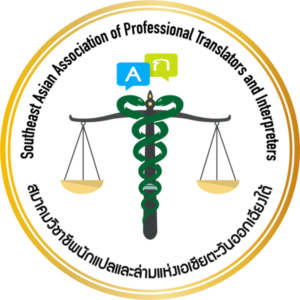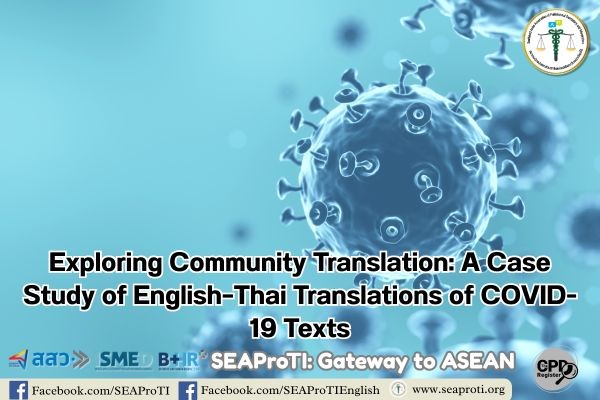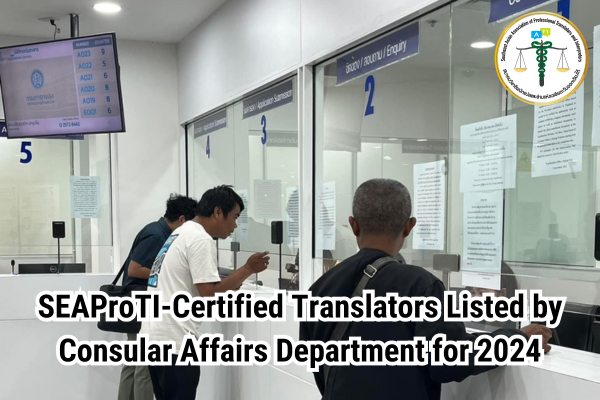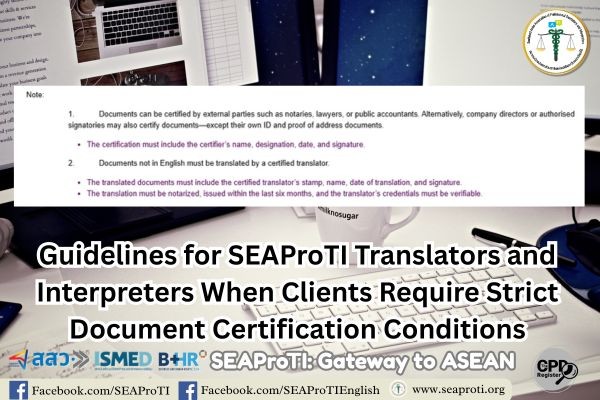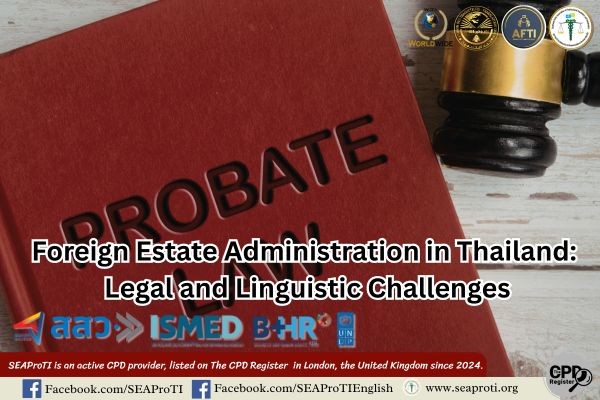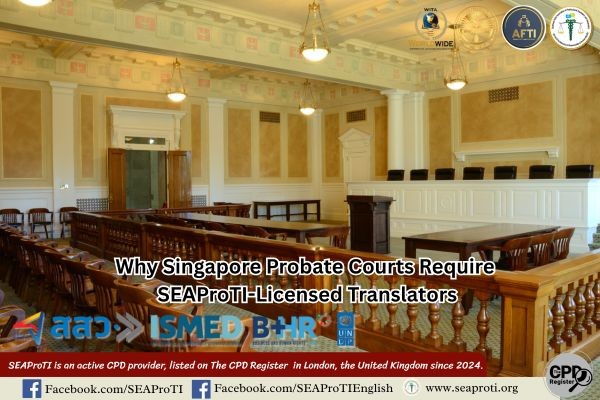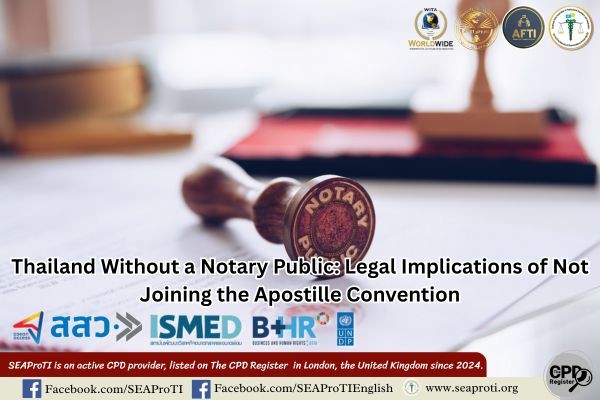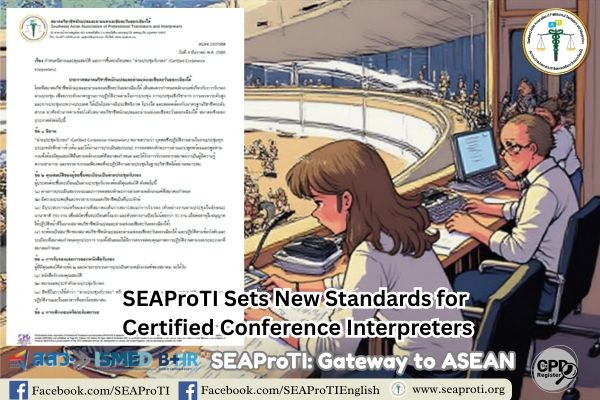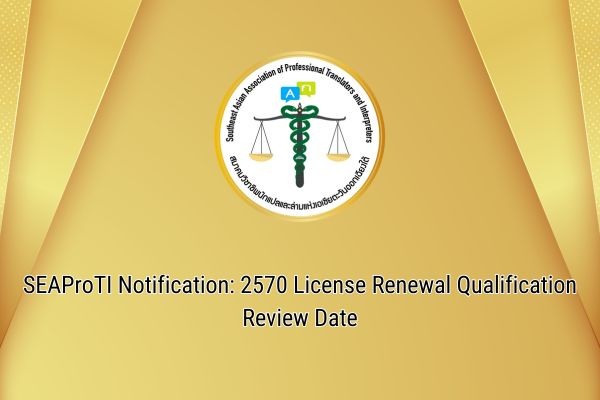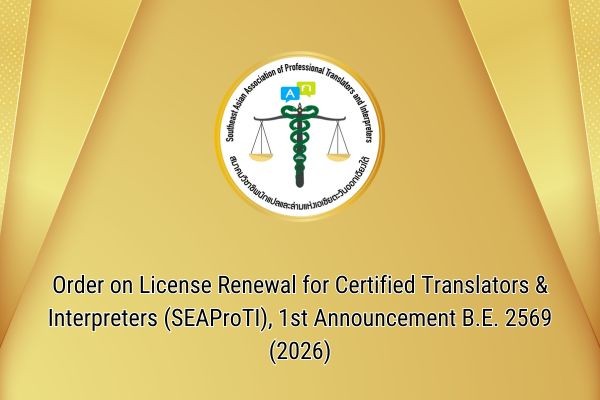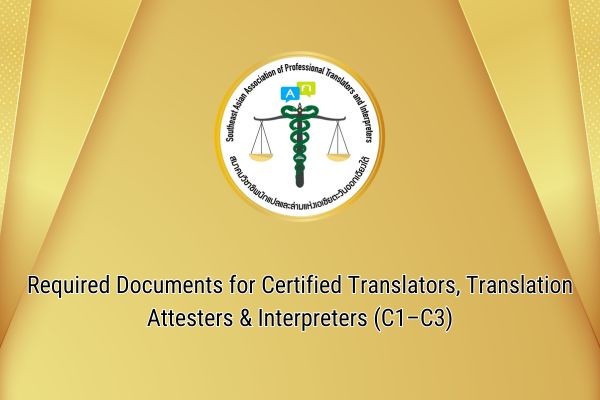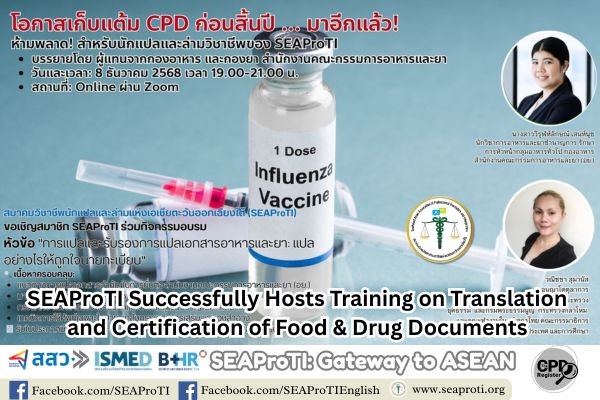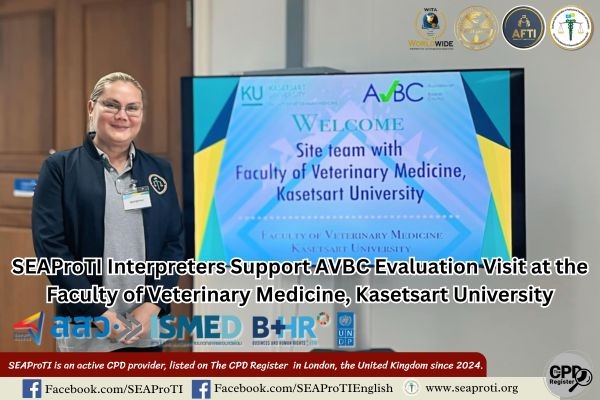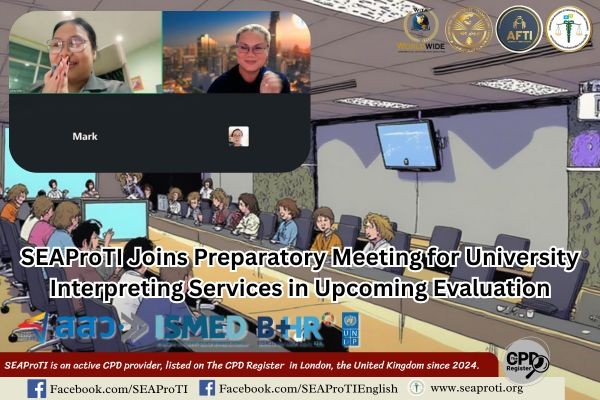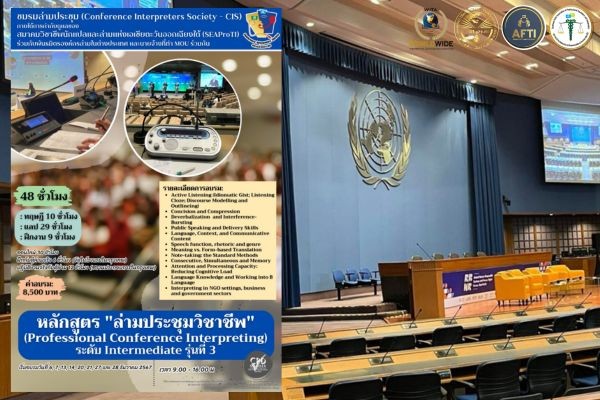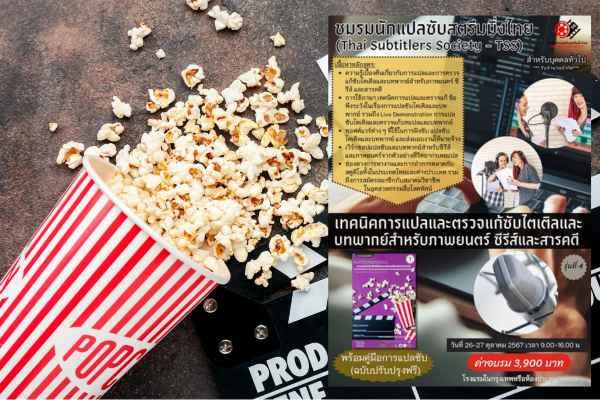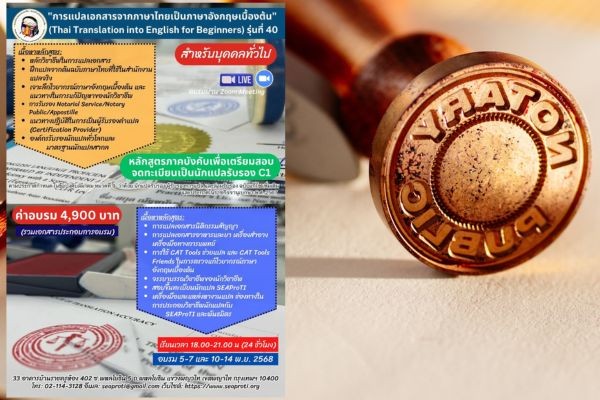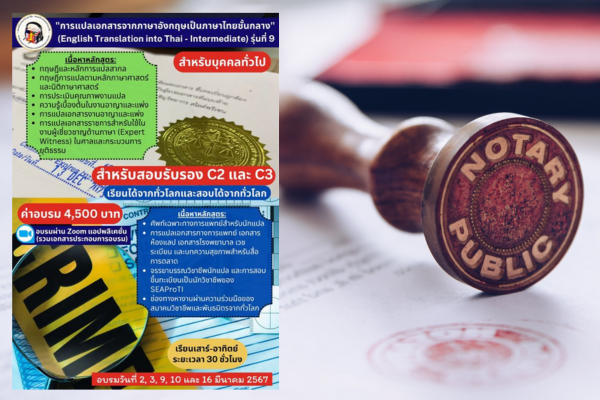Exploring Community Translation: A Case Study of English–Thai Translations of COVID-19 Texts
Author: Wanitcha Sumanat, Southeast Asian Association of Professional Translators and Interpreters (SEAProTI)
13 October 2025
Abstract
This study aims to examine how English-to-Thai translations of COVID-19 information were produced, distributed, and received during the pandemic, with a focus on the concept of community translation—a translation practice that promotes accessibility and social inclusion. Using a qualitative research design, semi-structured interviews were conducted with 15 participants, including professional translators, interpreters, language educators, and public health communicators. The study explores criteria for high-quality community translation, linguistic and cultural challenges in public health translation, and participants’ evaluations of existing COVID-19 translations disseminated in Thailand.
Findings reveal that effective community translation must be reader-oriented, culturally sensitive, and terminologically accurate. While government translations were found to be factually precise, they often lacked naturalness and clarity for general audiences. Volunteer translations, on the other hand, demonstrated higher accessibility and readability but occasionally compromised terminological accuracy.
The study concludes by proposing best-practice guidelines for community translation in Thailand and Southeast Asia to enhance linguistic equity and the reliability of public health communication.
Keywords: community translation, English–Thai translation, COVID-19, public health communication
1. Introduction
The COVID-19 pandemic underscored the critical importance of clear, accessible, and multilingual communication in public health. As global health authorities such as the World Health Organization (WHO) primarily disseminate information in English, translation into local languages becomes vital to ensuring comprehension and compliance among non-English-speaking populations.
In Thailand, large volumes of COVID-19 information were translated into Thai by diverse actors—government agencies, professional translators, volunteers, and online communities. These practices reflect the principles of community translation, which emphasize inclusivity, accessibility, and social responsibility (Ozolins, 2014; Taibi & Ozolins, 2016).
Despite the abundance of translated materials, few studies have examined the processes, linguistic quality, and cultural appropriateness of English–Thai COVID-19 translations. This study, therefore, investigates the professional and linguistic dimensions of community translation in Thailand during the pandemic, aiming to establish criteria for quality and propose context-specific best practices.
2. Research Objectives
- To investigate the production, distribution, and reception of English–Thai COVID-19 translations in Thailand.
- To identify quality criteria for community translation in public health contexts.
- To analyze linguistic and cultural challenges faced by translators of health-related materials.
- To propose best-practice guidelines for community translation in Thailand.
3. Methodology
3.1 Research Design
The research employed a qualitative approach using semi-structured interviews to obtain in-depth perspectives from experienced language professionals.
3.2 Participants
Fifteen participants were selected through purposive sampling, consisting of:
- Six professional translators and interpreters
- Five language educators and linguists
- Four public health communicators
3.3 Data Collection and Analysis
Each participant participated in a one-hour semi-structured interview conducted via online conferencing. Data were transcribed and analyzed using thematic content analysis following Braun and Clarke (2006). The main analytical themes included:
- Accuracy and reliability of translated content
- Comprehensibility and readability
- Cultural sensitivity
- Trustworthiness of information sources
4. Findings
4.1 Criteria for High-Quality Community Translation
Participants agreed that reader comprehension should take precedence over literal linguistic fidelity. High-quality community translation was characterized by:
- Accuracy: Content must align with source information and verified scientific facts.
- Clarity: Language must be simple, direct, and accessible to the general public.
- Cultural Sensitivity: Translators must avoid stigmatizing or fear-inducing expressions and adapt messages to local sociocultural norms.
4.2 Linguistic and Cultural Challenges
Key difficulties included translating specialized public health terms such as social distancing, droplet transmission, and asymptomatic carrier, which lack precise equivalents in Thai. The term “เว้นระยะห่างทางสังคม” (“social distance”) was noted as potentially misleading, since it may connote social detachment rather than physical distancing. Government-issued translations were often accurate but overly formal, while volunteer translations tended to use more relatable language but risked misinterpreting technical terminology.
4.3 Evaluation of COVID-19 Translations in Thailand
- Government Translations: High factual accuracy but overly bureaucratic tone that hindered comprehension among general audiences.
- Volunteer Translations: Accessible and reader-friendly but occasionally inaccurate in medical terminology.
- Media and Online Translations: Creative and engaging but often lacked citation of reliable sources and sometimes distorted key information.
5. Discussion
The findings support the framework of Taibi and Ozolins (2016), who describe community translation as a socially engaged act of communication, rather than mere linguistic transfer. Effective translation in crisis situations requires collaboration between linguists, public health professionals, and policymakers to balance factual accuracy with communicative clarity.
In Thailand, challenges arise from the gap between institutional translation practices (which prioritize formality and precision) and the communication needs of ordinary citizens. This calls for a hybrid translation model that combines linguistic accuracy with localized adaptation and user-focused communication.
6. Conclusion and Recommendations
Community translation during crises such as the COVID-19 pandemic is essential for ensuring equitable access to information and protecting public health. Based on the study’s findings, the following recommendations are proposed:
- Establish a National Community Translation Taskforce to standardize terminology and oversee translation quality in emergencies.
- Develop Best-Practice Guidelines for translating public information across government and media institutions.
- Provide Professional Training for translators and communicators in public health translation to strengthen interdisciplinary collaboration.
These measures would help institutionalize community translation as a vital component of public communication strategy in Thailand and the wider Southeast Asian region.
References
- Braun, V., & Clarke, V. (2006). Using thematic analysis in psychology. Qualitative Research in Psychology, 3(2), 77–101.
- Ozolins, U. (2014). Describing community interpreting: A case study in healthcare, legal and local government settings. John Benjamins.
- Taibi, M., & Ozolins, U. (2016). Community translation. Bloomsbury Academic.
- World Health Organization. (2020). COVID-19 public health communications guidance. WHO Publications.
About Certified Translators, Translation Certifiers, and Certified Interpreters of SEAProTI
The Southeast Asian Association of Professional Translators and Interpreters (SEAProTI) has formally announced the qualifications and requirements for registration of Certified Translators, Translation Certification Providers, and Certified Interpreters in Sections 9 and 10 of the Royal Gazette, published by the Secretariat of the Cabinet, Office of the Prime Minister of Thailand, on 25 July 2024 (Vol. 141, Part 66 Ng, p. 100). Certified Translators, Translation Certification Providers, and Certified Interpreters
The Council of State has proposed the enactment of a Royal Decree, granting registered translators and recognized translation certifiers from professional associations or accredited language institutions the authority to provide legally valid translation certification (Letter to SEAProTI dated April 28, 2025)
SEAProTI is the first professional association in Thailand and Southeast Asia to implement a comprehensive certification system for translators, certifiers, and interpreters.
Head Office: Baan Ratchakru Building, No. 33, Room 402, Soi Phahonyothin 5, Phahonyothin Road, Phaya Thai District, Bangkok 10400, Thailand
Email: hello@seaproti.com | Tel.: (+66) 2-114-3128 (Office hours: Mon–Fri, 09:00–17:00)
การสำรวจการแปลเพื่อชุมชน: กรณีศึกษาการแปลภาษาอังกฤษ–ไทยของข้อความเกี่ยวกับโรคโควิด-19
(Exploring Community Translation: A Case Study of English–Thai Translations of COVID-19 Texts)
ผู้วิจัย: วณิชชา สุมานัส, สมาคมวิชาชีพนักแปลและล่ามแห่งเอเชียตะวันออกเฉียงใต้ (SEAProTI)
13 ตุลาคม 2568
บทคัดย่อ
การวิจัยนี้มีวัตถุประสงค์เพื่อศึกษากระบวนการผลิต การเผยแพร่ และการรับรู้ของผู้ใช้ต่อข้อความภาษาไทยที่แปลจากภาษาอังกฤษเกี่ยวกับโรคโควิด-19 ในช่วงการแพร่ระบาด โดยเน้นบริบทของ “การแปลเพื่อชุมชน” (Community Translation) ซึ่งมุ่งให้ประชาชนทั่วไปเข้าถึงข้อมูลสำคัญอย่างถูกต้องและเข้าใจง่าย การศึกษานี้ใช้ระเบียบวิธีเชิงคุณภาพ ผ่านการสัมภาษณ์กึ่งโครงสร้างกับนักแปล ล่าม อาจารย์สอนภาษา และนักสื่อสารด้านสาธารณสุขจำนวน 15 คน เพื่อสำรวจเกณฑ์การแปลที่มีคุณภาพ ปัญหาทางภาษาและวัฒนธรรม และการประเมินคุณภาพของงานแปลที่เผยแพร่ในประเทศไทย
ผลการศึกษาพบว่า การแปลเพื่อชุมชนที่มีประสิทธิภาพต้องคำนึงถึง (1) ความเข้าใจของผู้รับสารเป็นสำคัญ (reader-oriented translation) (2) ความเหมาะสมของศัพท์สาธารณสุขในบริบทไทย และ (3) ความอ่อนไหวต่อวัฒนธรรมและระดับความรู้ของประชาชน ทั้งนี้ งานแปลของหน่วยงานราชการมีความถูกต้องในระดับข้อมูล แต่ขาดการปรับภาษาให้เข้ากับการสื่อสารในชีวิตประจำวัน ในขณะที่งานแปลโดยอาสาสมัครมีความยืดหยุ่นและเข้าใจง่ายกว่า แต่ขาดการตรวจสอบความถูกต้องของศัพท์ทางเทคนิค
ผลลัพธ์ของการศึกษาได้นำไปสู่ข้อเสนอแนะแนวทางปฏิบัติที่ดี (Best Practice Guidelines) สำหรับการแปลเพื่อชุมชนในประเทศไทย ซึ่งสามารถประยุกต์ใช้ในบริบทสาธารณสุขและการสื่อสารภาครัฐในอนาคต
คำสำคัญ: การแปลเพื่อชุมชน, การแปลภาษาอังกฤษ–ไทย, โควิด-19, การสื่อสารสาธารณสุข
1. บทนำ
การระบาดของโรคโควิด-19 ตั้งแต่ปี พ.ศ. 2563 ได้เผยให้เห็นความสำคัญของการสื่อสารข้อมูลสาธารณสุขที่เข้าใจง่ายและเข้าถึงได้ในทุกระดับภาษา การแปลข้อความจากภาษาอังกฤษซึ่งเป็นภาษาหลักขององค์การอนามัยโลก (WHO) และหน่วยงานระหว่างประเทศจึงมีบทบาทสำคัญต่อการเผยแพร่ข้อมูลในประเทศไทย
อย่างไรก็ตาม การแปลเหล่านี้มิได้เกิดขึ้นจากนักแปลมืออาชีพเท่านั้น แต่ยังรวมถึงอาสาสมัคร หน่วยงานรัฐ สื่อออนไลน์ และนักสื่อสารในชุมชน ซึ่งสะท้อนแนวคิดของ “การแปลเพื่อชุมชน” (Community Translation) ที่เน้นความเท่าเทียมทางภาษาและสิทธิของผู้รับสารในการเข้าถึงข้อมูลที่เข้าใจได้ (Ozolins, 2014; Taibi & Ozolins, 2016)
ในบริบทของประเทศไทย แม้จะมีงานแปลจำนวนมากเกี่ยวกับโควิด-19 แต่ยังขาดการศึกษาเชิงลึกเกี่ยวกับคุณภาพของการแปล การใช้ศัพท์สาธารณสุข และความเข้าใจของผู้รับสาร การวิจัยนี้จึงมุ่งสำรวจเกณฑ์ คุณลักษณะ และปัญหาของการแปลลักษณะนี้ เพื่อสร้างแนวทางปฏิบัติที่ดีสำหรับการแปลเพื่อชุมชนในอนาคต
2. วัตถุประสงค์ของการวิจัย
- เพื่อศึกษากระบวนการผลิตและเผยแพร่ข้อความแปลภาษาอังกฤษ–ไทยเกี่ยวกับโควิด-19
- เพื่อสำรวจเกณฑ์คุณภาพของการแปลเพื่อชุมชนในมุมมองของนักแปลมืออาชีพและผู้ปฏิบัติงานด้านภาษา
- เพื่อวิเคราะห์ปัญหาทางภาษาและวัฒนธรรมในการแปลข้อมูลสาธารณสุข
- เพื่อเสนอแนวทางปฏิบัติที่ดีในการแปลข้อมูลสาธารณะในประเทศไทย
3. ระเบียบวิธีวิจัย
การวิจัยนี้ใช้ระเบียบวิธีเชิงคุณภาพ (Qualitative Research Design) โดยใช้การสัมภาษณ์แบบกึ่งโครงสร้าง (Semi-Structured Interview) กับผู้ให้ข้อมูลจำนวน 15 คน ซึ่งประกอบด้วย
- นักแปลและล่ามมืออาชีพ (6 คน)
- อาจารย์สอนภาษาและภาษาศาสตร์ (5 คน)
- นักสื่อสารด้านสาธารณสุข (4 คน)
เกณฑ์การเลือกกลุ่มตัวอย่าง:
ผู้ที่มีประสบการณ์ตรงในการแปลหรือเผยแพร่ข้อมูลสาธารณสุขในช่วงปี พ.ศ. 2563–2565
กระบวนการวิเคราะห์ข้อมูล:
ใช้การวิเคราะห์เนื้อหาเชิงธีม (Thematic Content Analysis) ตามแนวทางของ Braun & Clarke (2006) โดยจัดกลุ่มข้อมูลออกเป็นธีมหลัก ได้แก่ ความถูกต้องของเนื้อหา, ความเข้าใจของผู้รับสาร, ความเหมาะสมทางวัฒนธรรม, และความน่าเชื่อถือของแหล่งข้อมูล
4. ผลการศึกษา
4.1 เกณฑ์ของการแปลเพื่อชุมชนที่มีคุณภาพ
ผู้ให้ข้อมูลส่วนใหญ่เห็นพ้องกันว่า งานแปลเพื่อชุมชนควรเน้น “การเข้าใจของผู้รับสารเป็นหลัก” มากกว่าความเที่ยงตรงทางไวยากรณ์เพียงอย่างเดียว โดยมีเกณฑ์สำคัญ 3 ประการ คือ
- ความถูกต้องของเนื้อหา (Accuracy): ข้อมูลต้องสอดคล้องกับต้นฉบับและหลักวิทยาศาสตร์
- ความเข้าใจง่าย (Clarity): ใช้คำศัพท์และโครงสร้างประโยคที่เข้าใจได้ในระดับการศึกษาทั่วไป
- ความไวต่อวัฒนธรรม (Cultural Sensitivity): หลีกเลี่ยงการใช้คำที่ก่อให้เกิดความตื่นตระหนกหรือความอับอาย
4.2 ปัญหาทางภาษาและวัฒนธรรม
นักแปลและนักสื่อสารหลายคนรายงานว่า คำศัพท์สาธารณสุขบางคำ เช่น social distancing, droplet transmission, หรือ asymptomatic carrier ไม่มีคำไทยที่สื่อความหมายตรงตัว การใช้คำว่า “เว้นระยะห่างทางสังคม” จึงถูกวิจารณ์ว่าอาจสร้างความเข้าใจคลาดเคลื่อน การแปลบางชุดใช้ภาษาราชการเกินไป ทำให้ประชาชนทั่วไปไม่เข้าใจ
4.3 การประเมินข้อความแปลที่เผยแพร่ในประเทศไทย
- ข้อความแปลของหน่วยงานราชการมีความถูกต้องสูง แต่ขาดการปรับภาษาให้สอดคล้องกับระดับความรู้ของประชาชน
- ข้อความแปลของอาสาสมัครเข้าใจง่ายกว่า แต่ขาดความแม่นยำในศัพท์เทคนิคและการอ้างอิงแหล่งข้อมูล
- ข้อความแปลโดยสื่อออนไลน์บางแห่งมีความสร้างสรรค์ แต่มีการดัดแปลงเนื้อหาจนคลาดเคลื่อนจากต้นฉบับ
5. อภิปรายผล
ผลการศึกษายืนยันแนวคิดของ Taibi & Ozolins (2016) ที่ว่าการแปลเพื่อชุมชนมิใช่เพียงการถ่ายทอดภาษา แต่เป็น “การสื่อสารเพื่อสังคม” ที่ต้องคำนึงถึงความเข้าใจ ความเท่าเทียม และการเข้าถึงของผู้รับสารในทุกกลุ่มประชากร
ในกรณีของประเทศไทย พบว่าความท้าทายหลักอยู่ที่การประสานระหว่างความถูกต้องทางวิชาการและความเข้าใจของประชาชน ซึ่งต้องอาศัยความร่วมมือระหว่างนักแปลมืออาชีพ หน่วยงานรัฐ และผู้เชี่ยวชาญด้านสาธารณสุข
6. บทสรุปและข้อเสนอแนะ
งานแปลเพื่อชุมชนในสถานการณ์วิกฤติ เช่น โควิด-19 เป็นเครื่องมือสำคัญในการคุ้มครองสุขภาพและสิทธิเข้าถึงข้อมูลของประชาชน การวิจัยนี้เสนอแนวทางการแปลเพื่อชุมชนที่มีคุณภาพ ดังนี้:
- จัดตั้ง คณะทำงานแปลเพื่อชุมชนระดับชาติ เพื่อกำหนดมาตรฐานการใช้ศัพท์และกระบวนการตรวจสอบคุณภาพ
- พัฒนา แนวปฏิบัติที่ดี (Best-Practice Guidelines) สำหรับหน่วยงานที่เผยแพร่ข้อมูลสาธารณะ
- ส่งเสริมการอบรมเชิงปฏิบัติการด้าน “การแปลเพื่อสาธารณสุข” แก่นักแปลและผู้สื่อสารภาษาไทย
เอกสารอ้างอิง
- Braun, V., & Clarke, V. (2006). Using thematic analysis in psychology. Qualitative Research in Psychology, 3(2), 77–101.
- Ozolins, U. (2014). Describing community interpreting: A case study in healthcare, legal and local government settings. John Benjamins.
- Taibi, M., & Ozolins, U. (2016). Community translation. Bloomsbury Academic.
- World Health Organization. (2020). COVID-19 public health communications guidance. WHO Publications.
เกี่ยวกับนักแปลรับรอง ผู้รับรองการแปล และล่ามรับรองของสมาคมวิชาชีพนักแปลและล่ามแห่งเอเชียตะวันออกเฉียงใต้
สมาคมวิชาชีพนักแปลและล่ามแห่งเอเชียตะวันออกเฉียงใต้ (SEAProTI) ได้ประกาศหลักเกณฑ์และคุณสมบัติผู้ที่ขึ้นทะเบียนเป็น “นักแปลรับรอง (Certified Translators) และผู้รับรองการแปล (Translation Certification Providers) และล่ามรับรอง (Certified Interpreters)” ของสมาคม หมวดที่ 9 และหมวดที่ 10 ในราชกิจจานุเบกษา ของสำนักเลขาธิการคณะรัฐมนตรี ในสำนักนายกรัฐมนตรี แห่งราชอาณาจักรไทย ลงวันที่ 25 ก.ค. 2567 เล่มที่ 141 ตอนที่ 66 ง หน้า 100 อ่านฉบับเต็มได้ที่: นักแปลรับรอง ผู้รับรองการแปล และล่ามรับรอง
สำนักคณะกรรมการกฤษฎีกาเสนอให้ตราเป็นพระราชกฤษฎีกา โดยกำหนดให้นักแปลที่ขึ้นทะเบียน รวมถึงผู้รับรองการแปลจากสมาคมวิชาชีพหรือสถาบันสอนภาษาที่มีการอบรมและขึ้นทะเบียน สามารถรับรองคำแปลได้ (จดหมายถึงสมาคม SEAProTI ลงวันที่ 28 เม.ย. 2568)
สมาคมวิชาชีพนักแปลและล่ามแห่งเอเชียตะวันออกเฉียงใต้ เป็นสมาคมวิชาชีพแห่งแรกในประเทศไทยและภูมิภาคเอเชียตะวันออกเฉียงใต้ที่มีระบบรับรองนักแปลรับรอง ผู้รับรองการแปล และล่ามรับรอง
สำนักงานใหญ่: อาคารบ้านราชครู เลขที่ 33 ห้อง 402 ซอยพหลโยธิน 5 ถนนพหลโยธิน แขวงพญาไท เขตพญาไท กรุงเทพมหานคร 10400 ประเทศไทย
อีเมล: hello@seaproti.com โทรศัพท์: (+66) 2-114-3128 (เวลาทำการ: วันจันทร์–วันศุกร์ เวลา 09.00–17.00 น.)
